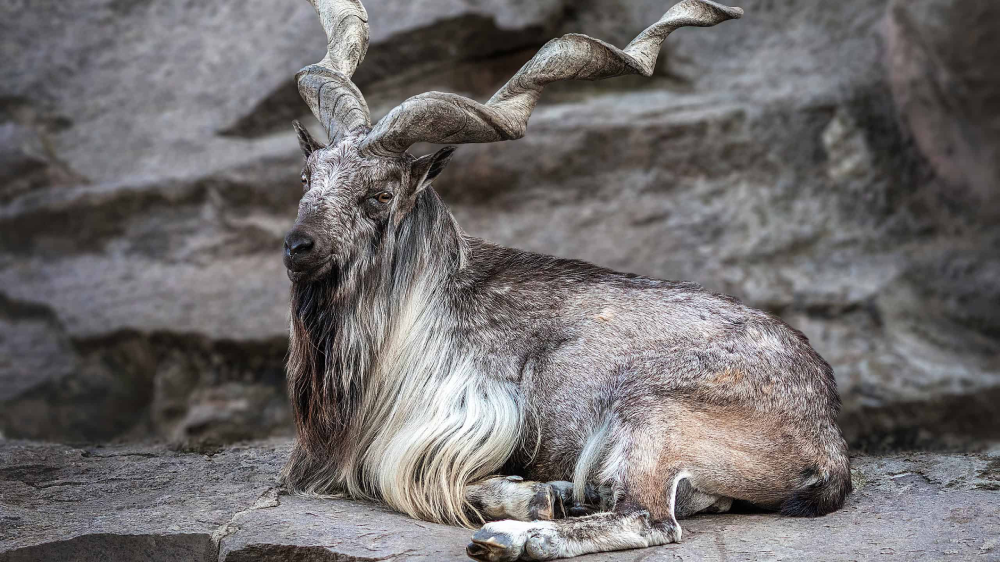In the rugged, mountainous terrain of Central Asia, roams a creature that captivates the imagination with its majestic horns and elusive presence – the Markhor (Capra falconeri). Often referred to as the king of wild goats, the Markhor is a symbol of resilience, adaptability, and the untamed beauty of the high-altitude landscapes it calls home.
Physical Characteristics
The Markhor is a large wild goat species belonging to the Capra genus. What sets it apart, particularly among the males, are its impressively spiraled horns, which can reach lengths of over 160 centimeters (63 inches). These corkscrew-shaped horns are a spectacle to behold, curling majestically backward and sometimes even twisting around each other. The horns serve not only as a symbol of dominance and attractiveness during mating season but also as formidable weapons used in territorial disputes and defense against predators.
In terms of appearance, Markhor exhibit a range of colorations depending on their geographic location and subspecies. Generally, their coat ranges from light brown to reddish-brown, with a lighter underbelly. They often possess a distinct white ‘beard,’ which adds to their charismatic appeal.

Habitat and Distribution
Markhor are adapted to the harsh, mountainous environments of Central Asia, where they navigate steep slopes, rocky terrain, and sparse vegetation with agility and grace. Their range spans across Afghanistan, Pakistan, Tajikistan, Uzbekistan, Turkmenistan, and India, with populations primarily concentrated in the mountainous regions of the Hindu Kush, Pamir, and Himalayan ranges.
Within these habitats, Markhor display remarkable adaptability, inhabiting a variety of ecosystems ranging from arid scrublands to alpine meadows and coniferous forests. They are popular for frequent cliffs and rocky outcrops, where they find refuge from predators and access to suitable forage.
Behavior and Social Structure
Markhor are predominantly crepuscular, meaning they are most active during the dawn and dusk hours, although they may also be active during the night. They are primarily browsers, feeding on a variety of vegetation including leaves, shoots, grasses, and herbs. During the harsh winter months when food is scarce, they may resort to browsing on twigs, shrubs, and even bark.
While Markhor are typically solitary animals, especially outside of the breeding season, they may form small groups known as ‘bachelor herds’ consisting of males, or mixed-sex groups composed of females and their young. These social structures are fluid, with individuals coming together and dispersing based on factors such as food availability and mating opportunities.
Conservation Status and Threats
Despite their resilience and adaptability, Markhor face numerous threats to their survival, primarily due to human activities. Habitat loss and fragmentation, resulting from deforestation, agricultural expansion, and infrastructure development, pose significant challenges to their long-term survival. Illegal hunting, driven by demand for their horns and meat, further exacerbates population declines.
Several conservation initiatives have been implemented across the Markhor’s range to mitigate these threats and safeguard their future. Efforts such as habitat conservation, anti-poaching patrols, community-based conservation programs, and captive breeding and reintroduction projects have shown promising results in stabilizing and increasing Markhor populations in certain areas.
Furthermore, international collaboration and awareness-raising efforts have been instrumental in garnering support for Markhor conservation, emphasizing the importance of preserving these iconic symbols of mountain wilderness for future generations to cherish and admire.
Conclusion
The Markhor, with its striking appearance, resilient nature, and symbolic significance, embodies the spirit of the high mountains it inhabits. As a flagship species for conservation in Central Asia, it serves as a reminder of the intrinsic value of wild spaces and the urgent need to protect and preserve them.
Through concerted conservation efforts, informed by scientific research, community engagement, and political will, we can ensure that the Markhor continues to roam the rugged slopes and rocky crags of its mountainous homeland for generations to come, enriching the natural heritage of our planet and inspiring awe and admiration in all who encounter it.









